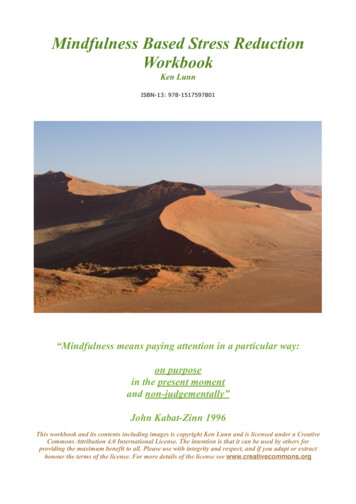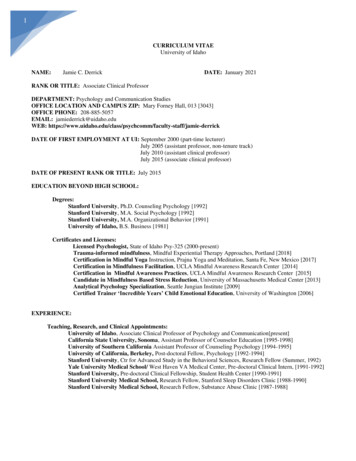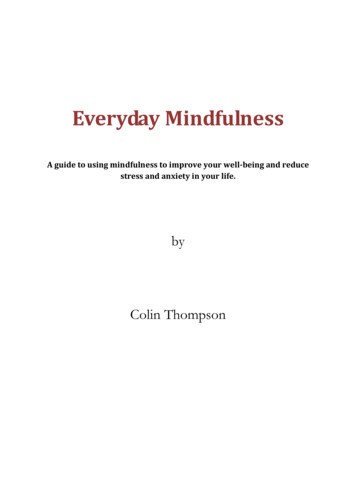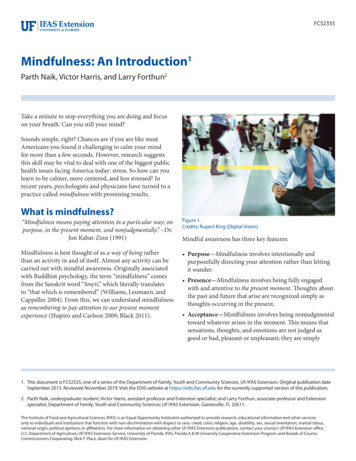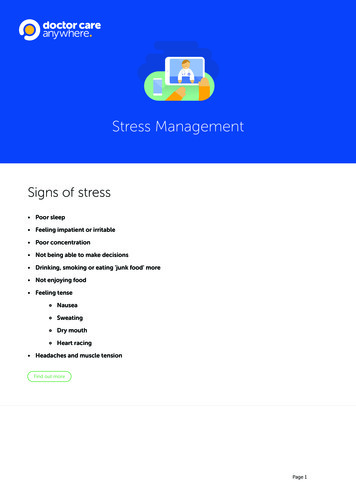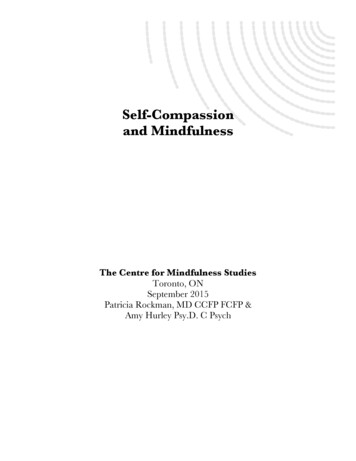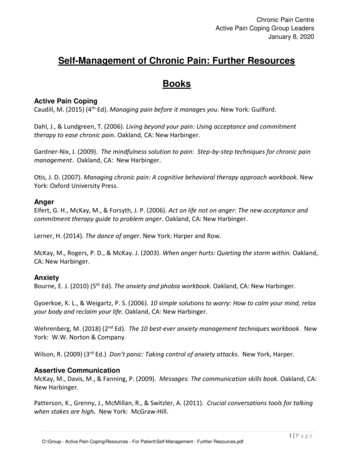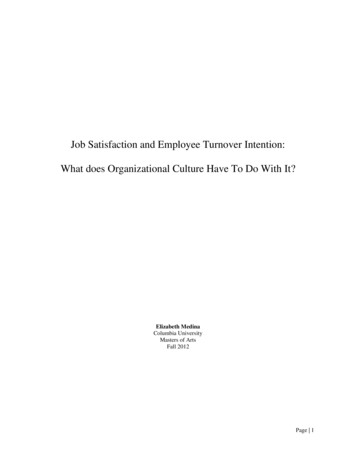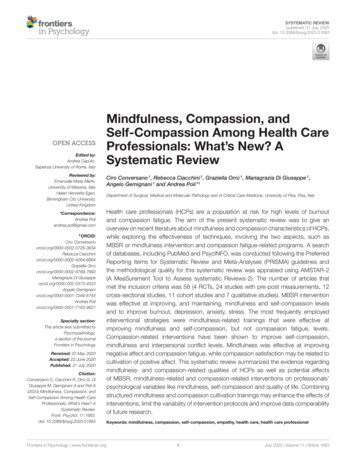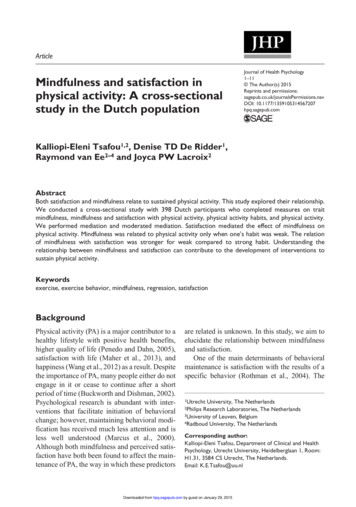
Transcription
67207Journal of Health PsychologyTsafou et al.ArticleMindfulness and satisfaction inphysical activity: A cross-sectionalstudy in the Dutch populationJournal of Health Psychology 1 –11 The Author(s) 2015Reprints and OI: eni Tsafou1,2, Denise TD De Ridder1,Raymond van Ee2–4 and Joyca PW Lacroix2AbstractBoth satisfaction and mindfulness relate to sustained physical activity. This study explored their relationship.We conducted a cross-sectional study with 398 Dutch participants who completed measures on traitmindfulness, mindfulness and satisfaction with physical activity, physical activity habits, and physical activity.We performed mediation and moderated mediation. Satisfaction mediated the effect of mindfulness onphysical activity. Mindfulness was related to physical activity only when one’s habit was weak. The relationof mindfulness with satisfaction was stronger for weak compared to strong habit. Understanding therelationship between mindfulness and satisfaction can contribute to the development of interventions tosustain physical activity.Keywordsexercise, exercise behavior, mindfulness, regression, satisfactionBackgroundPhysical activity (PA) is a major contributor to ahealthy lifestyle with positive health benefits,higher quality of life (Penedo and Dahn, 2005),satisfaction with life (Maher et al., 2013), andhappiness (Wang et al., 2012) as a result. Despitethe importance of PA, many people either do notengage in it or cease to continue after a shortperiod of time (Buckworth and Dishman, 2002).Psychological research is abundant with interventions that facilitate initiation of behavioralchange; however, maintaining behavioral modification has received much less attention and isless well understood (Marcus et al., 2000).Although both mindfulness and perceived satisfaction have both been found to affect the maintenance of PA, the way in which these predictorsare related is unknown. In this study, we aim toelucidate the relationship between mindfulnessand satisfaction.One of the main determinants of behavioralmaintenance is satisfaction with the results of aspecific behavior (Rothman et al., 2004). The1UtrechtUniversity, The NetherlandsResearch Laboratories, The Netherlands3University of Leuven, Belgium4Radboud University, The Netherlands2PhilipsCorresponding author:Kalliopi-Eleni Tsafou, Department of Clinical and HealthPsychology, Utrecht University, Heidelberglaan 1, Room:H1.31, 3584 CS Utrecht, The Netherlands.Email: K.E.Tsafou@uu.nlDownloaded from hpq.sagepub.com by guest on January 29, 2015
2Journal of Health Psychology importance of satisfaction has received empiricalsupport in various behavioral domains, includingsmoking cessation (Hertel et al., 2008), weightloss (Baldwin et al., 2009; Finch et al., 2005),and PA (Williams et al., 2008). Despite theimpressive findings on the role of satisfaction inhealth behavior maintenance, little is knownabout the exact underlying mechanisms involvedin experiencing satisfaction. Rothman et al.(2004) argued that satisfaction justifies the effortexerted in initiating the new behavior andthereby leads to experiencing positive emotions.This is important because general positive affectat a 2-year follow-up was found to predict maintenance at a 5 years follow-up of PA, when controlling for previous PA (McAuley et al., 2007).The development of effective health behaviorchange interventions would benefit from a better understanding of the mechanisms which canbe influenced to increase satisfaction withbehavior change.Several studies suggest that a focus on positive affective reactions following engagementin the behavior may play an essential role inexperiencing satisfaction. Baldwin et al. (2013)demonstrated that daily satisfaction is related toa variety of specific positive experiences withPA such as believing one is closer to attainingone’s goal. These findings suggest that enhancing positive experiences increases satisfaction,which in turn contributes to maintaining a newbehavior. An important factor in experiencingsatisfaction with a new behavior may lie inbeing mindful about the new activity. In thisarticle, we examine to what extent being mindful during PA can relate to experienced satisfaction with one’s behavior and subsequentlyaffect the performance of PA. A challenge wheninvestigating satisfaction is that people tend tohabituate to the pleasure they may derive fromthe new behavior. Drawing on examples fromthe literature on weight loss, the experiencedbenefit of the new behavior decreases overtime, and this may account for the failure ofsustained weight loss because of less satisfaction with the behavior (Jeffery et al., 2004).Stated differently, remaining alert to ongoingchanges and experiences during a new behaviorcould enhance perceived satisfaction with thatbehavior (Rothman et al., 2009).One of the techniques to enhance awarenessof experiences that has received an increasingamount of attention in the past decade is mindfulness. Mindfulness has been operationalizedin multiple ways (for a discussion, see Chiesa,2013), either as a one-dimensional construct(Brown and Ryan, 2003) or a multi-dimensionalconstruct encompassing acceptance, non-judgment, and the skill to take an objective stancetoward one’s experiences (Baer et al., 2006;Bishop et al., 2004). In this study, we adhere tothe widely accepted definition that mindfulnessis a one-dimensional construct that constitutesawareness of what is happening in the presentmoment (Brown and Ryan, 2003). We agreewith Brown and Ryan (2003) that the principalquality of mindfulness is awareness which leadsto the formation of other qualities, such asacceptance and non-judgment.Mindfulness has been found to predict wellbeing (Brown and Ryan, 2003) and to relate toenhanced experience of positive emotions(Brown and Ryan, 2003; Erisman and Roemer,2010; Geschwind et al., 2011; Greenberg andMeiran, 2014; Jislin-Goldberg et al., 2012;Killingsworth and Gilbert, 2010). Importantly,a number of studies have investigated the relationship between mindfulness (or mindfulnessrelated exercises) and PA. Mindfulness is higheramong exercisers who are in the maintenancephase (Ulmer et al., 2010), mindfulness interventions can increase PA (Tapper et al., 2009),and mindful exercises (such as yoga) have beenshown to positively alter one’s mood followinga single session (Netz and Lidor, 2003). Theseare promising indications that mindfulnessrelates to PA; however, the mechanisms of theserelationships are yet to be defined. We arguethat mindfulness may intensify the recognitionand experience of positive instances as relevantfor the experience of satisfaction with PA. Morespecifically, being mindful may help to becomemore aware of the positive aspects of PA andthe experienced feeling of being satisfied withPA. As Rothman (2000) argued whereas initiation depends on future expectations with theDownloaded from hpq.sagepub.com by guest on January 29, 2015
3Tsafou et al.outcomes of a behavior, maintenance relies onthe experience of the behavior (Rothman et al.,2004).As such, because positive experiencesenhance satisfaction (Baldwin et al., 2013),being mindful during PA increases the chanceto become aware of positive experiences duringPA, and therefore, it may contribute to experiencing stronger satisfaction with PA. The temporal sequence is, thus, that one first preformsPA in a mindful way and therefore experiencessatisfaction. One could arguably wonderwhether the sequence of events could bereversed (e.g. satisfaction preceding mindfulness). To our view, the sequence we providehere is more plausible than an alternative one.To explain, satisfaction is an evaluation that isformulated during or after one is performingPA. Therefore, PA should first be performedand then evaluated. Mindfulness, on the otherhand, is a state in which one is aware of concurrent experiences during PA. In this sense, onecan be mindful during PA. Following this reasoning, being mindful during PA precedes satisfaction which is an evaluation that needs to beformed after one has performed PA.The relationship between satisfaction, mindfulness, and PA may be affected by the habitualtendency to perform PA. Behavior may becomehabitual after it has been performed consistently for a given period of time and is executedrelatively effortlessly (Verplanken and Orbel,2003). It is plausible that a habit precludesattention to momentary experiences during PA,because the behavior is performed automatically. This could relate to someone being lessmindful and therefore experiencing decreasedsatisfaction. On the other hand, some researchers argue that what becomes automatic is thedecision to perform an activity, and therefore,an activity can still remain pleasant (Verplankenand Melkevik, 2008). Another alternative possibility is that satisfaction ceases to play animportant role when one had developed a habitof PA (Rothman et al., 2004), and thus, the presence of a habit might be a sufficient predictor offuture PA. In this case, mindfulness and satisfaction might become less strong predictors ofPA. For these reasons, we included PA habitstrength as an exploratory variable in this study.This studyWe hypothesize that mindfulness relates tomore PA and that this relationship is mediatedby satisfaction. For exploratory purposes, weexamine whether the mediation model is moderated by habitual PA. Finally, we explorewhether satisfaction, mindfulness during PA,and habit differ in the group of initiators andmaintainers.MethodParticipantsWe recruited participants via the Dutch onlineagency PanelClix. Participants were Dutchspeaking and 18–65 years old. They were compensated according to the agency’s point system. Of the 501 original respondents, 103 wereexcluded, for the following reasons: mistakes infilling out the International Physical ActivityQuestionnaire (IPAQ) (n 36), not conformingto the IPAQ protocol (n 54), and physicalinactivity (defined as not meeting the recommended criteria of at least 10 minutes per incident; n 13). The final sample included 398participants. No significant differences werefound between the excluded participants (basedon mistakes, N 36, and the IPAQ protocol,N 54) and the final sample (N 398) on gender, education, work, and working hours, bodymass index (BMI), trait mindfulness, mindfulness in PA, PA habits, or satisfaction (allp’s .14). The group of non-active participants(N 13) was not included in this analysis,because physical inactivity precludes by definition being mindful during PA and experiencingsatisfaction with PA.ProcedureParticipants received an email with the surveylink and completed the survey after informedconsent. The study was approved by the InternalDownloaded from hpq.sagepub.com by guest on January 29, 2015
4Journal of Health Psychology Committee Biomedical Experiments (ICBE) ofPhilips Research Laboratories in Eindhoven.Participants were informed that the aim of thestudy was to gain insight into people’s habitsregarding PA.MeasuresDemographics. Age, gender, height, weight,education, working status, and working hourswere assessed. Height and weight were used tocalculate the BMI (kg/m2).Descriptives. Duration of PA (1, 2, or 3 weeks, 1,2, 3, 4, 5, 6, or more than 6 months), performingmuscle strength and flexibility exercises (yes/no), experience with mindfulness (yes/no), andpracticing mindfulness daily (minutes/day).The 15-item Dutch version of the MindfulAttention and Awareness Scale (MAAS)(α .92) (Schroevers et al. 2008) by Brown andRyan (2003) measures the tendency to be awareof present-moment experiences. Responses areon a 6-point scale from 1 (almost always) to 6(almost never). Higher mean scores indicatemore mindfulness.The seven-item IPAQ short form (Craiget al. 2003) measures PA. Participants indicatehow many days, hours, and minutes they spentlast week on vigorous and moderate PA, andwalking for at least 10 minutes per incident.They also report sitting (this is not used in thePA score and is therefore not reported here).Subsequently, the metabolic equivalent of atask (MET; an indicator of metabolic energyexpenditure) is calculated by multiplyingdays minutes MET value (3.3 for walking, 4for moderate, and 8 for vigorous activity). Thedata were processed according to the IPAQResearch Committee guidelines (Guidelinesfor Data Processing and Analysis of theInternational Physical Activity Questionnaire(IPAQ), 2005) as follows: first, the values fromhours were translated into minutes. Values of“15, 30, 45, 60, or 90” in the hours box weretransferred to the minutes’ column. Participantswho made mistakes not addressed in the protocol (e.g. value of “1.15”) were excluded.Second, assuming that one sleeps 8 hours daily,participants were excluded when the sum ofweekly physical activities exceeded 6720 minutes (i.e. 16 hours/day 60 minutes 7 days)(N 2). Third, participants who replied “I amnot sure” were excluded (N 52). Fourth, truncation (re-coding) was performed. Any givenactivity above 3 hours was re-coded to 3 hours,permitting a maximum value of 21 hours peractivity (3 hours 7 days) and 63 hours of allPA combined per week. Finally, due to theskewed distributions, the MET values were logtransformed.The Self-Report Habit Index (SRHI) (α .94)(Verplanken and Orbel, 2003) comprises 12items and measures habit strength. In this study,a 5-point scale was used from 1 (totally agree)to 5 (totally disagree). All items were reversescored, and higher mean scores indicate strongerhabits for PA. A sample item is “physical activity is something I do automatically.”Participants were asked to provide a plan orgoal that they might have on PA. The aim forthis was to facilitate their responding beforeproceeding to the next questions, without, however, explicitly indicating this.Mindfulness in Physical Activity (MFPA;α .84) is a scale that was specifically designedfor this study and comprises six items1 withanswers ranging from 1 (totally agree) to 5(totally disagree).1 This measure was includedbecause previous research (Brown and Ryan,2003) has demonstrated that mindfulness mayvary over specific activities regardless of one’sdispositional tendency for mindfulness. The present scale assesses mindfulness during PA. Thequestionnaire begins with the statement “WhenI am doing physical activity” followed by theitems “I am not distracted by thoughts and emotions,” “I am aware of what I am doing,” “I amfocused on what I am doing,” “I notice what Iam doing right now,” “I am fully absorbed in it,”and “I am feeling OK with what I am doing.”Satisfaction with PA (α .90) was measuredwith an eight-item scale that was developed forthis study. This scale extends previous one-itemassessments of satisfaction (Baldwin et al.,2013; Finch et al., 2005). This scale measuresDownloaded from hpq.sagepub.com by guest on January 29, 2015
5Tsafou et al.satisfaction with the outcomes of PA and theengagement in (i.e. during) PA. Answers weregiven on a 5-point scale from 1 (totally agree)to 5 (totally disagree). The questionnaire beginswith the statement “When I am doing physicalactivity” followed by the items “I am satisfiedwith the results of/I am satisfied with/I enjoy/Ifeel good when I have done/I notice positiveresults if I have done physical activity,”“Physical activity has many advantages,” and “Ifind physical activity nice/difficult.”We also collected data on enjoyment with PAwith the Physical Activity Enjoyment Scale(PACES; Mullen et al. 2011). The scale wasincluded as an exploratory variable and is notdirectly linked to the assumptions tested in thisstudy. Our interest was to explore how it mightbe related to satisfaction with PA (r .77,p .000). Our conceptualization of satisfactionduring PA, as demonstrated from the strong correlation with the PACES scale, resembles thedefinition of enjoyment, conceptualized frequently as pleasure and a positive affective state(Kimiecik and Harris, 1996). Further information can be obtained from the first author.PA per week, which accumulated to 4066 METvalues (SD 3394). Similar values have beenreported in other studies in the Netherlands (Botet al., 2013; Rütten et al., 2003). In Bot et al.(2013), two studies report mean values of 3.600(SD 2.9) and 9.300 (SD 17.3). In Rüttenet al. (2003), the reported mean value is 5543.95(SD 6931.69). However, it should be pointedout that IPAQ sometimes leads to over-reportingof moderate and intense PA (Bauman et al.,2009; Rzewnicki et al., 2003). Typical physicalactivities that were reported included walking,housework tasks (e.g. cleaning), cycling, aswell as sport. Most participants indicated tohave been following the reported behavioralpattern for more than 6 months (70.4%), while46 percent reported being more active, 32.7 percent equally active, and 21.4 percent less activecompared to before this period. The samplesizes between the different groups (e.g. performing PA for a few weeks, a few months ormore that 6 months) were very unequal to yieldreliable comparisons. The means, SDs, and correlations of the scales are presented in Table 1.Main analysesResultsDescriptivesThe sample consisted of 398 participants, ofwhom 198 (49.7%) were males, with an average age of 41.28 years (standard deviationSD 13.27) and an average BMI of 25.20(SD 4.51); 71.6 percent were working on average 23.36 hours/week (SD 16.54); 17.3 percent had completed low-level education,52 percent middle-level education, and 30.6 percent high-level education. Participants reportedmoderate trait mindfulness (M 3.83, SD .85),and 32 participants had participated in a previous mindfulness training (8%), whereas 29(7.3%) practiced either mindfulness or meditation, for 2–180 minutes per day. A total of43.7 percent performed activities to increasemuscle strength and 26.4 percent activities thatinvolve flexibility (e.g. yoga). Participantsreported on average 848 (SD 653) minutes ofTo test our hypothesis that mindfulness relatesto PA via satisfaction, a mediation analysis wasconducted following the procedure describedby Baron and Kenny (1986), with three regression analyses. First, we tested whether PA waspredicted by mindfulness. As expected, theeffect was positive and significant (β .26,p .001). Second, we tested whether satisfaction was related to mindfulness, and this effectproved also significant (β .57, p .001). Third,mindfulness and satisfaction were both enteredas predictors of PA. Both satisfaction (β .27,p .001) and mindfulness (β .11, p .048) predicted PA. We then used bootstrapping with10,000 re-samples to calculate the indirecteffects and the confidence intervals (CIs;Preacher and Hayes, 2008). The indirect effectwas 0.094 (standard error (SE) .029), 95 percent CI (.043; .155), the completely standardized indirect effect was .151 (SE .043), and95 percent CI (.071; .241). The Kappa-squaredDownloaded from hpq.sagepub.com by guest on January 29, 2015
6Journal of Health Psychology Table 1. Means, standard deviations, and correlation of the scales.1. MF in PAa (5-point scale)2. Satisfaction (5-point scale)3. Trait MFb (6-point scale)4. Habit mean (5-point scale)5. PA **SD: standard deviation; PA: physical activity; MET: metabolic equivalent of a task.aMindfulness in physical activity (MF in PA).bMindful Attention and Awareness Scale (MAAS).cLog-transformed variable.***p .001.was .129 (SE .035), 95 percent CI (.061;.198), and is interpreted as the proportion of themaximum indirect effect that could haveoccurred (Preacher and Kelley, 2011). Kappasquared may be interpreted similarly to Cohen’sr in terms of its magnitude (Preacher and Kelley,2011). The reported effect is a medium (.09)effect size. Thus, the analysis confirms ourhypothesis that satisfaction is a significantmediator in the relationship between mindfulness and PA.To explore the role of habit, we did a moderated mediation analysis as proposed by Mulleret al. (2005) to test whether the mediation effectdiffers as a function of the moderator. To demonstrate moderated mediation, either of the following two conditions should be satisfied.Either the direct effect of the predictor on themediator and the interaction mediator moderator on the outcome are significant or the interaction predictor moderator on the mediatorand the direct effect of the mediator on the outcome is significant. All variables and theirinteractions were mean centered.First, PA was regressed on mindfulness (predictor), habit (moderator), and their interaction.The model was significant F(3,394) 22.59,p .001. Both main effects, that is, of mindfulness (p .01) and habit (p .001), were significant, as well as their interaction, β .12,p .013, which indicates a moderation of thetotal effect of mindfulness on PA. To betterunderstand the interaction, we conducted a simple slopes analysis, at 1 SD of habit mean. Forweak PA habits, the effect of mindfulness during PA was significant β .24, p .001, whereasfor strong PA habits, the effect was not significant (p .686). This indicates that mindfulnessaffects PA only in cases where habitual PA isweak.Second, satisfaction (mediator) wasregressed on mindfulness, habit, and theirinteraction. The model was significantF(3,394) 120.99, p .001. Both the effect ofmindfulness (p .001) and habit (p .001), andtheir interaction was significant, β .093,p .011. To further examine this effect, simpleslope analysis was again performed 1 SD ofhabit mean. The effect of mindfulness on satisfaction was significant for both cases, but itwas stronger for weak (β .46, p .001) thanfor strong habit (β .29, p .001), which suggest that when people have weak habitual PA,mindfulness impacts satisfaction more thanwhen people have strong habitual PA.Finally, PA was regressed on mindfulness,satisfaction, habit, and the interactions of mindfulness habit and satisfaction habit. Themodel was significant F(5,392) 15.26, p .001.Only the effect of satisfaction (p .049) and habitstrength (p .001) was significant. Mindfulness(p .142) and the interactions mindfulness habit(p .541) and satisfaction habit (p .093) werenot significant. The significant interaction mindfulness habit in the second model and the significant main effect of satisfaction in the thirdmodel satisfy the two conditions of moderatedmediation (Muller et al., 2005). To summarize,Downloaded from hpq.sagepub.com by guest on January 29, 2015
7Tsafou et al.the results demonstrate that mindfulness has astronger effect on satisfaction when one has aweak habit for PA, whereas the impact of mindfulness on PA is present only for those with aweak habit to perform PA.Post hoc analysisTo address the potential of a reverse timesequence between satisfaction and mindfulness,we conducted an alternative mediational modelin which satisfaction was entered as the predictor and mindfulness as the mediator. The indirect effect based on bootstrapping with 10,000re-samples (Preacher and Hayes, 2008) was notsignificant, because the value 0 is contained inthe CI, .038 (SE .024), 95 percent CI ( .007,.086). Therefore, an alternative sequence ofevents is not supported statistically.DiscussionThis study examined whether mindfulnessrelates to PA via satisfaction with PA. We foundthat increased mindfulness during PA wasrelated to increased PA and that this relationshipwas mediated by how satisfied one feels withPA. This is in line with previous findings thathave demonstrated that being mindful can facilitate awareness of positive emotions (Erismanand Roemer, 2010; Jislin-Goldberg et al. 2012),that mindfulness is related to PA maintenance(Ulmer et al., 2010), and that satisfaction with anew behavior relates to increases in that behavior (Baldwin et al., 2013).This study extends previous research in twoways. First, it supports Rothman’s theory(Rothman, 2000; Rothman et al., 2004) whichstates that satisfaction with the outcomes of abehavior is an important factor for performing abehavior (Baldwin et al., 2013). Second, andmost importantly, it provides preliminary evidence on the relationship between mindfulnessand satisfaction. Mindfulness has been shownto relate to well-being and happiness (e.g.Brown and Ryan, 2003; Killingsworth andGilbert, 2010) and to enhance positive affectiveexperiences (e.g. Jislin-Goldberg et al. 2012).In this study, we extend these findings by applying mindfulness in the field of PA and to satisfaction. Establishing that mindfulness isassociated with satisfaction assists the design ofnew types of behavioral interventions. If indeedmindfulness facilitates or strengthens the feelings of satisfaction with one’s experiences, thisfinding can contribute to and extend the effortsto understand and influence behavioral maintenance (Conner, 2008; De Wit, 2006; Rothmanet al., 2004). Moreover, it provides new routesfor investigating interventions which couldenhance the continuation of health-promotingbehaviors and more specifically of PA.We also explored how the habit to performPA might interfere in the relationship betweenmindfulness, satisfaction, and PA. The association of mindfulness and PA was significant whenhabit was weak, indicating that with a stronghabit, mindfulness might cease to play an important role. Mindfulness related to satisfactionboth when habit was weak or strong. This finding could potentially shed light on the relationship of mindfulness with habit. In contrast to thecase of altering unhealthy habits where mindfulness and habit might be opposing (e.g. mindfulness has been used to disrupt habitual impulsivesnacking; Papies et al., 2012), it is plausible thatwith health-enhancing behaviors they operatehand in hand. Mindfulness entails being awareand absorbed in a current experience. In thatsense, it is non-evaluative and involves noother cognitive processing. Similarly, a habitualbehavior indicates that a specific action is a partof a person’s daily life and does not require conscious deliberation (Verplanken and Orbel,2003). As Verplanken and Melkevik (2008)have argued, a habitual behavior does notexclude deriving pleasure from performing abehavior and this could be an explanation onwhy mindfulness might relate to satisfactionboth when habit is weak or strong. Finally, therelationship of satisfaction with PA was notmoderated by habit, indicating that higher satisfaction leads to more PA irrespective of someone’s habit strength.Downloaded from hpq.sagepub.com by guest on January 29, 2015
8Journal of Health Psychology Limitations and implicationsIn addressing the limitations of the study, we firstnote that the data were collected at one timepoint; therefore, inferences about causality areimpossible and mediation effects should be interpreted with caution (Mackinnon et al., 2007;Muller et al., 2005). However, our post hoc analysis with satisfaction as the predictor and mindfulness as the mediator provided insufficientstatistical support for the alternative indirecteffect, therefore making our suggested modelmore plausible that an alternative sequence.Second, due to the unequal sample sizes ofrespondents having performed PA for less than6 months (N 117, 29.7%) and more than6 months (70%), it was not feasible to conductanalyses dividing the group into meaningful subgroups, to test differences between the early (initiation) and the later (maintenance) phases ofbehavioral change. However, the moderatingrole of habit strength in the model could offerinsights on the function of mindfulness and satisfaction when one is in the later phases of behavioral change. This phase is related to themaintenance of a specific behavior over anextended period of time. Although there is debateabout the exact definition of maintenance (e.g.De Wit, 2006), some argue that habit is an automatic determinant of maintenance (Rothmanet al., 2009). In line with this view, habit strengthcould be considered as a measure that reflectsmaintenance of a behavior.Third, the large amount of missing data andmistakes in the behavioral measure of PA (IPAQ)combined with the inherent problems of selfreport measures poses limitations concerningthe validity of the main outcome variable.Missing values in the IPAQ have also beenreported elsewhere, ranging from around 10 percent (e.g. Schmidt et al., 2008) up to 43 percent(Williams et al., 2011), without, however, a clearexplanation. Nevertheless, the IPAQ remains avalidated instrument, with clear protocol guidelines for its scoring.We suggest that an in-depth understanding ofmindfulness and its relationship to satisfaction isessential for developing new types of interventions that promote sustained behavioral changein PA. Future studies might consider generatinghypotheses based on the mediation model testedin this study and to test these relationships withexperimental manipulations and prospectivedesigns, or by exploring possible moderators(e.g. duration of PA). We further recommendthat future research should explore how beingmindful with respect to both positive and negative experiences leads to satisfaction with PAand, eventually, to sustained increased PA. PAcan at times be demanding and accompanied byphysically unpleasant sensations. Conceptually,mindfulness helps one to be aware of all experiences irrespective of their valence (positive vs.negative). As such, when one experiences PA ina mindful way, this would lead to recognition ofall related experiences (both positive and negative). Although it is plausible that the recognition of negative experiences could decreasesatisfaction, being mindful about negativeaspects of PA does not necessarily translate intoaversion of those states. Mindfulness-basedinterventions have shown repeatedly that mindf
related exercises) and PA. Mindfulness is higher among exercisers who are in the maintenance phase (Ulmer et al., 2010), mindfulness inter-ventions can increase PA (Tapper et al., 2009), and mindful exercises (such as yoga) have been shown to positively alter one’s mood
